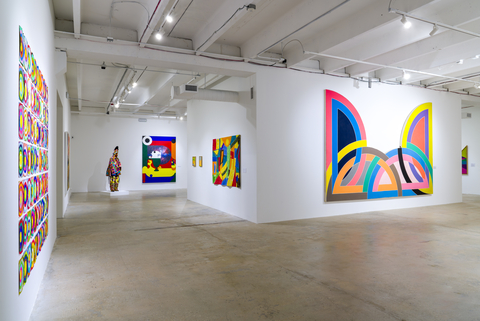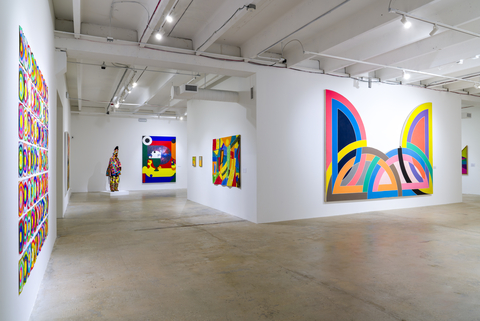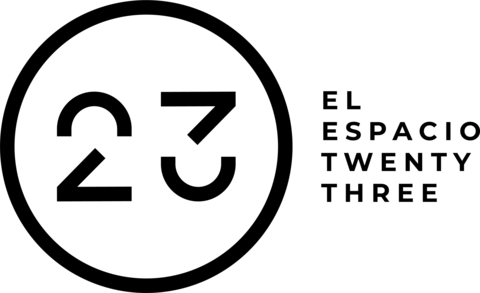MIAMI--(BUSINESS WIRE)--El Espacio 23 (EE23) – the contemporary art space founded by leading philanthropist, entrepreneur and art collector Jorge M. Pérez – has debuted its highly anticipated fourth exhibition, titled To Weave the Sky: Textile Abstractions from the Jorge M. Pérez Collection. On display from Nov. 2, 2023 to August 2024, the show celebrates numerous textile-based works from the Pérez collection – many of which have never been publicly exhibited before – and engages these acquisitions as focal points from which to structure creative dialogues with artworks presented in other mediums. The exhibition highlights works from historic and contemporary artists.
“Art will always serve as a universal language that helps bridge cultures and brings people together,” said Jorge M. Pérez. “Textile works in particular open up a unique window into many diverse traditions, showing how everyday materials and timeless craftsmanship can come together to inspire new, unique methods of creative expression. We look forward to the meaningful dialogues that will come about as a result of this latest show.”
Featuring works from over 100 intergenerational artists from around the world, To Weave the Sky is inspired by weaving’s traditional ties to abstraction and geometry, landscape and the organic, tactility and intimacy, and indigenous cosmologies and ritual. Curated by Tobias Ostrander, Estrellita B. Brodsky Curator at Large, Latin America at Tate Modern, in close dialogue with curators of the Pérez Collection, Patricia M. Hanna and Anelys Alvarez, the show attempts to uncover contemporary fascination with the medium – one that has been historically marginalized to the genre of craft within Western art contexts.
“Our interest in textile-based works, whether sewn, woven, quilted, or collaged, arose about ten years ago when the Pérez Collection acquired works by Olga de Amaral, Robert Motherwell, Polly Apfelbaum, Frances Trombly and Ximena Garrido Lecca, all of whom are included in this exhibition,” says Hanna. “In previous exhibitions, we’ve honed in on a specific geographic region or overarching theme. With this year’s show, we wanted to honor the centuries-old tradition of textiles. When conceptualizing the exhibition, we allowed the textile-based contemporary works in the collection to be the catalyst and inspiration for the dialogues created among the artists.”
To Weave the Sky features five distinct sections, all of which contribute to the overall exploration of textile abstractions:
- Chromatic Structures: This section of the exhibition celebrates the “color-blocking” present in many of the works displayed and how they articulate a dynamic play between the sensuality and optic dynamism of strong color and the mathematical rationality of geometry. Works include those by renowned artists such as Kenneth Noland, Gene Davis, and Frank Stella, as well as younger artists such as Patrick Dean Hubbell, Ad Minolitti, Candida Alvarez and Miami-based Frances Trombly.
- Landscape Gestures: The paintings and contemporary weavings brought together in this group explore aesthetics that connect formal abstraction to land, textiles, organic materials and rectilinear patterning. It takes inspiration from several Abstract Expressionist artists who were directly inspired by landscape and wove paint across their surfaces in gestures that recall the rhythmic rituals of weaving. Various artworks engage palettes and tones that reference organic matter, with several others referencing the sky and shifts of light across a landscape. Multiple compositions recall the patchworks of agricultural plots of land, while additional pieces are produced using materials associated with extractive landscape histories. This section includes paintings by Helen Frankenthaler, Joan Mitchell and Lee Krasner, as well as contemporary weavings by Igshaan Adams, Sanford Biggers, Nnenna Okore and Kapwani Kiwanga.
- Spiritual Constellations: Indigenous cosmologies that tie weaving to spiritual knowledge inform many of the works in this section, the majority of which draw from Latin American or African ancestral traditions. Gold is engaged in several works as both an alchemical material and a Pre-Hispanic and Spanish Colonial symbol of divine light. Relations between knots, numerical sequences and astrology are evoked in multiple pieces. Weavings in the form of nets link several works to rivers and their cultural significance as sacred and life-giving sites. Andean traditions that recognize woven fabrics as living “beings,” whose organic fibers contain vital energies, are references for additional works. Others engage African textiles and symbols historically related to status and power. This section includes works by Olga de Amaral, Rubem Valentim, Sheila Hicks, Ernesto Neto, Eamon Ore-Giron and Carolina Caycedo.
- Political Fabric: This section presents works that engage fabrics, felt, clothing and embroidery to describe recent political situations and histories. Multiple works address displacement and migration conflicts, while others speak to feminist protest and activism. Tapestries, as ancient narrative forms, are engaged to depict examples of contemporary economic and political violence. Works by Teresa Margolles, Reynier Leyva Novo, Laura Lima, Ellen Lesperance and Ana Gallardo are showcased.
- Threadbare: This area of the exhibition uses the metaphor of a threadbare fabric to present works that speak to emotional exposure, with the artist's works addressing issues of identity and psychological vulnerability. References to the bare human body, to Freudian traditions of exploring the self, and to beds and quilting as sites of both storytelling and desire, inform these works. This section includes pieces by Faith Ringgold, Ghada Amer, Philip Pearlstein, Guillermo Kuitca, Małgorzata Mirga-Tas, Yanira Collado and Bisa Butler.
To supplement the exhibit, EE23 will publish an accompanying catalog titled To Weave the Sky: Textile Abstractions from the Jorge M. Pérez Collection. The fully illustrated book features an essay by Ostrander and newly commissioned interviews with artists Polly Apfelbaum, Carolina Caycedo, Yanira Collado, Patrick Dean Hubbel and Nnenna Okore.
As part of the show, EE23 will also continue its ongoing residency program, welcoming two new artists during the same week – Patrick Dean Hubbell and Maria A. Guzmán Capron. EE23 will welcome additional artists throughout 2024 including Irene Infantes, Yanelis Mora, Alice Wagner and Manuel Chavajay, among others.
Visitors can enjoy the show free of charge. Hours of operation are Thursday to Saturday, 10am to 5pm. To reserve a time, and for more information about guided tours, please visit www.elespacio23.com or email info@elespacio23.com. Walk-ins are also welcome.
A full artist checklist is available for the media upon request.
About El Espacio 23
El Espacio 23 (EE23) is a contemporary art space founded by collector and philanthropist Jorge M. Pérez. Opened in 2019, EE23 is located within a repurposed 28,000 square foot warehouse in Miami’s Allapattah neighborhood, El Espacio 23 serves artists, curators and the general public with regular exhibitions, residencies and a variety of special projects drawn from the world renown Jorge M. Pérez Contemporary Art Collection.




